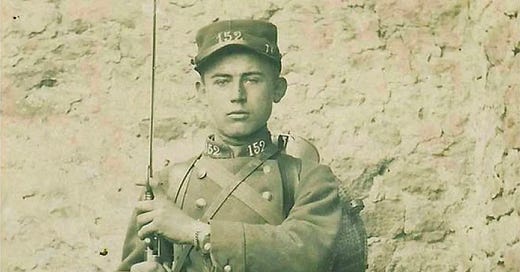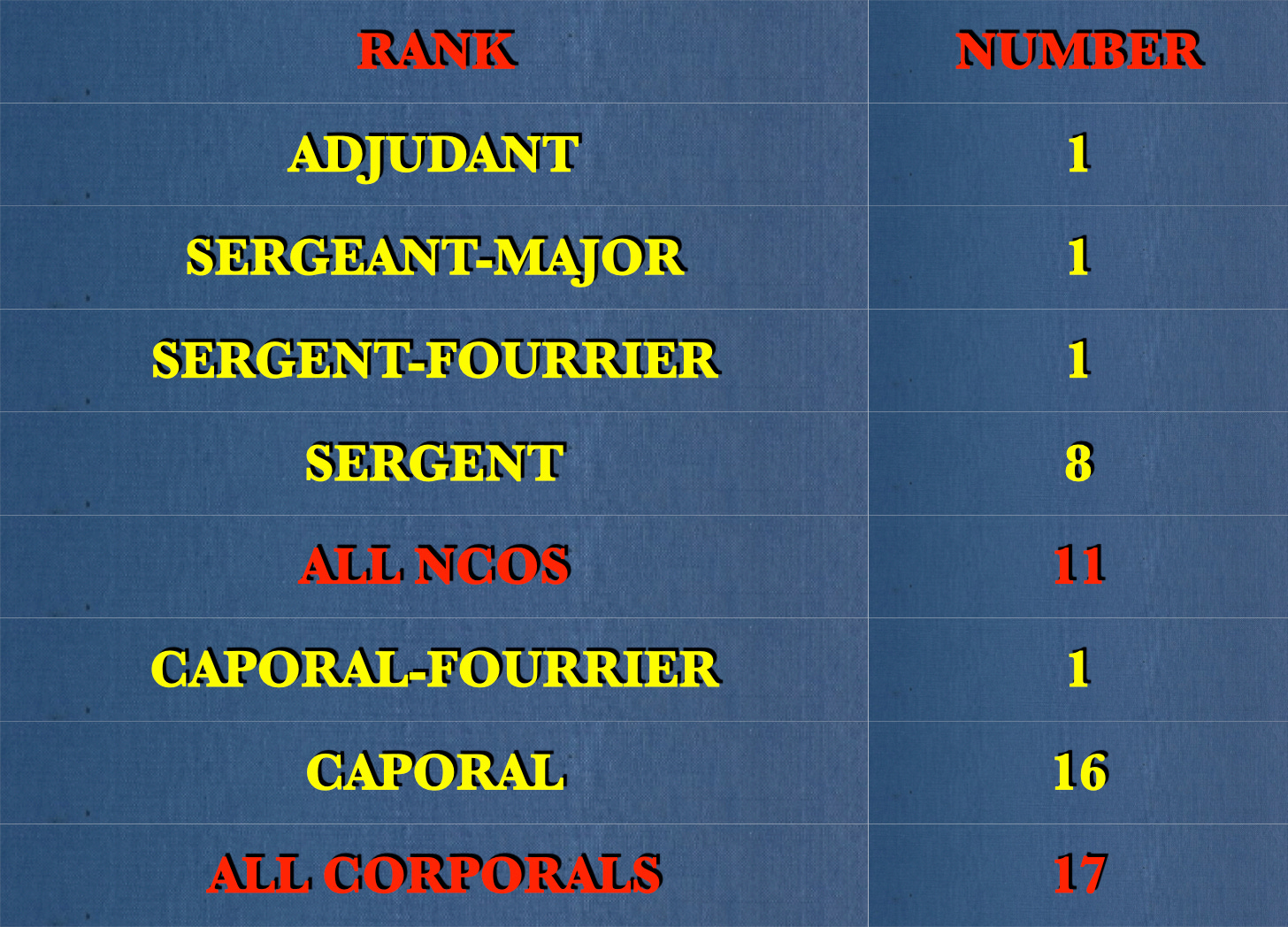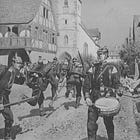The article that follows is an improved version of a piece originally published in January of 2023, when The Tactical Notebook was knee high to a grasshopper. (These improvements include the reformatting of illustrations, the adding of links to online copies of works cited, and the correction of minor mistakes.)
In 1914, the organization of the smaller units of the French infantry followed a binary scheme. Two squads (escouades) made a section (demi-section.) Two sections made a platoon (section.) Two platoons made a half-company (peloton.) [1] Two half-companies made a company (compagnie.)
While some other contemporary armies viewed the subdivisions of a company as temporary groupings, to be formed at the start of a day’s training and dissolved when the company was dismissed for the evening, the French Army provided its squads, sections, and platoons with a more durable existence. To that end, it had adopted a policy of providing each of these organizations with a permanently assigned leader, an officer, non-commissioned officer, or corporal whose chief concern and definitive duty was the handling, performance, and well-being of his platoon, section, or squad.
The one exception to the practice of permanently-constituted company subdivisions was provided by the all-but-vestigial institution of the half-company.[2] As a rule, a company commander would give orders directly to his four platoon commanders. However, on those rare occasions when a company commander employed two platoons to accomplish a mission that would take them beyond his immediate supervision for a substantial period of time, he would form those two platoons into a half-company. Thus, for example, when a company commander was asked to provide a half-company to serve as the advanced guard of a battalion, he would bring two platoons together and appoint the senior of the two platoon commanders as the leader of the whole.[3]
At any given time, the size of a particular platoon, section, or squad was a function of the size of the company to which it belonged. Thus, if a company was mobilized with all of the 222 private soldiers it was supposed to have, each platoon would consist of either 55 or 56 such men. Similarly, 27 or 28 privates would serve with each section and 13 or 14 privates would be assigned to each squad.
Within each company, 12 privates were assigned to duties that kept them out of the firing line. (These men served as stretcher bearers, teamsters, musicians, or medical orderlies.) Thus, when a company was at full strength, 210 of its 222 privates were available for service in the firing line.[4] This meant that, when a full-strength company deployed for combat, the typical squad consisted of a corporal and 13 riflemen; the typical section of a sergeant, 2 corporals, and 26 riflemen; and the typical platoon of a platoon leader, 2 sergeants, 4 corporals, and 52 riflemen.[5]
After slight differences in the number of privates assigned, the chief source of variation among the four platoons of a French infantry company of 1914 was the rank of the platoon leader. The senior lieutenant of the company, ideally one who ranked as a first lieutenant (lieutenant) of the peacetime army, took command of the first platoon. The next lieutenant in the hierarchy, ideally a second lieutenant (sous-lieutenant) of the peacetime army, took charge of the fourth platoon.[6] The junior lieutenant, who was presumed to be a reserve second lieutenant (sous-lieutenant de réserve), led the second platoon. (In the absence of this officer, command of the second platoon devolved to the sergeant-major.) Finally, supervision of the third platoon was given to the senior non-commissioned officer of the company, who wore the rank of adjudant. [7]
The peculiar way in which leaders were matched to platoons seems to have been a function of a desire to place the two senior subaltern officers of the company at the extremities of any given formation. That is, when the company was arrayed in column, with each section following its predecessor, this arrangement ensured that there would be a lieutenant of the peacetime army at either end of the queue. Likewise, when the company was in line, with the four sections forming a row, this pattern of assignment placed a professional officer on either flank. This pattern of assignment, in which peacetime officers alternated with platoon commanders of other sorts, also facilitated the formation of half-companies.
When not assigned as platoon leaders, senior non-commissioned officers were distributed among platoons to serve as “file-closers” (serre-files).[8] As the name suggests, file-closers took up positions in the rear of the firing line in order to allow the platoon commander to focus on the orders he received, the actions of the enemy, and the decisions he needed to take. In addition to ensuring that commands were heard, understood, and executed, the file-closer “used all available means to maintain discipline in the ranks.”[9]
File-closers played a particularly important role in the firefight, transmitting fire commands, supervising the expenditure of ammunition, and correcting any obvious errors (such as firing too high, firing wildly, or not firing at all) that individual riflemen might make. File-closers also made sure that no man left the firing line without authorization, that the cartridges of casualties were made available to those still able to fire, and that those ordered to move forward did so without hesitation.[10] In these respects, the duties of file-closers were qualitatively different from those of the platoon leaders, who were charged with choosing firing positions, selecting targets, and evaluating the impact of fire upon the enemy. In other words, while platoon leaders made decisions, file-closers enforced rules.
Senior non-commissioned officers were not the only file-closers in a company. Rather, they were joined in that role by the one corporal who was not a squad leader (the caporal-fourrier) and the eight sergeants assigned as section leaders. Indeed, the roles of section leader and file-closer overlapped to such a degree that a semi-official manual for small unit leaders used the terms “sergeant” and “file-closer” as if they were synonyms.[11]
The corporals serving as squad leaders served neither as tactical decision-makers nor as battlefield supervisors.[12] Rather, the tasks that separated squad leaders from other members of the rank and fire lay chiefly in the realm of interior economy. Whether in barracks, billets, or bivouacs, corporals supervised the care of weapons, clothing, and equipment; ensured the cleanliness and good order of living areas; and provided the privates of their squads with a model of “discipline, good conduct, exactitude, and the proper wearing of the uniform.” As the squad also served as a mess, squad leaders were also responsible for ensuring that rations issued as raw ingredients were properly cooked. [13] On the battlefield, however, the corporal was just another rifleman. “In action” wrote a French officer in 1910, “the corporal is no more than an ordinary soldier. He does not command, but fires in the same way as other soldiers. We only hope that he will set a good example.”[14]
The limited roles that file-closers and corporals were expected to play on the battlefield made it possible for one military writer to argue, without exaggeration or irony, that the platoon leader “commands the unit without intermediaries. His role is powerful because it belongs to the moral realm. It is not knowledge that he needs to dislodge the enemy from the position that he covets, but force of character, moral energy, warlike ardor. And he does not possess these powerful qualities for his own sake, but for the sake of the fifty wills that follow him.”[15]
The clearest illustration of the central role played by platoon commanders in the pre-war tactics of the French infantry is provided by the official description of the most basic of battlefield techniques of the era of the magazine rifle, the one that soldiers of the English-speaking world called “fire and movement.” The infantry regulations in force for most of the decade preceding the outbreak of war (Décret du 3 décembre 1904 portant règlement sur les manœuvres de l'infanterie), taught that, while taking part in an attack, a platoon would be expected to engage in both fire and movement. At any given time, however, it would be doing only one of those things. “As a rule,” the manual stated, “fire is carried out by platoon. It begins and ends on the command of the platoon leaders. Its intensity is governed circumstances and the objective to be attained.”[16]
In keeping with the idea of the platoon as an essentially indivisible unit, that portion of the infantry regulations of 1904 that dealt with combat (as opposed to drill, ceremony, and formations) devoted but a single paragraph to the duties of non-commissioned officers. “The non-commissioned officer assists the officer, and may be called to take his place. He constantly serves as an example of self-denial and the spirit of sacrifice. He oversees the execution of orders. He uses all of his influence to ensure the most exact discipline and uses all available means to ensure that soldiers do their duty.”[17] Furthermore, this same chapter of the regulations, which filled 64 paragraphs and 30 pages, made no mention whatsoever of sections, squads, or corporals.
On 20 April 1914, the adoption of a new infantry manual (Règlement de manœuvre d’infanterie) changed official expectations of the roles that platoon commanders, file-closers, and squad leaders were to play in the firefight. In particular, the new manual empowered platoon commanders to delegate authority for the direction of fire to file-closers. (These file-closers might be the leaders of permanently constituted sections. They might also be non-commissioned officers who had been placed in charge of fractions, portions of a platoon that did not necessarily correspond to permanently constituted sections or squads.) The new manual also gave squad leaders responsibility for supervising such things as the setting of sights and the consumption of ammunition, while, at the same time, relieving them of the duty of serving as riflemen.[18] In other words, the new manual gave file-closers a role that had previously been the province of platoon commanders and squad leaders a job that had once belonged exclusively to file-closers, thereby replacing fire and movement by platoons with fire and movement within platoons.
On 16 May 1914, the minister of war, Joseph Noulens, wrote a letter to his senior uniformed subordinates, informing them that the new manual would come into force on 1 October 1914 and that, in preparation for that event, the officers in charge of infantry regiments should, starting in the month of June, begin to familiarize their commands with the new methods. At the same time, Noulens added, commanders should do nothing that would interfere with plans for progressive training that were already in place. Thus, as the summer months were customarily devoted to the training of companies, battalions, and complete regiments, this order made it difficult for infantry units to devote much time to learning the new small unit tactics before the outbreak of war in August of 1914.[19]
For Further Reading:
To Share, Subscribe, or Support:
[1]The component elements of French infantry companies were larger than the English-language cognates of their designations would suggest. For that reason, I have chosen to translate peloton as “half-company,” section as “platoon,” and demi-section as “section.”
[2]For examples, see Auguste Massacrier, Les Missions à la guerre d’un chef de section, (Paris: Berger-Levrault, 1910), pp. 84, 94, 97-98, and 107.
[3]For hypothetical examples of the tactical employment of half-companies, see Le Livre de gradé d’infanterie, (Paris: Berger-Levrault, 1913), p. 183 and France, Ministère de la Guerre, Règlement de manœuvre d’infanterie de 20 avril 1914, (Paris: Fournier, 1914), pp. 102 and 148. For a case of the employment of a half company in combat in Morocco in 1913, see Alexandre Percin, Le Combat, (Paris: Félix Alcan, 1914), p. 77.
[4]Le Livre du gradé d'infanterie (1913), p. 332
[5]When one divides 210 by 16, there is a remainder of 2. Thus, within each full-strength company, two squads were each provided with a fourteenth rifleman.
[6]In 1912, a shortage of subaltern officers led to the creation of the rank of adjudant-chef. While classed as non-commissioned officers, adjudants-chefs served in positions, such as command of the fourth platoon of an infantry company, that had previously been reserved for lieutenants. Loi autorisant la nomination, en 1912, d’un certain nombre d’adjudants chefs dans les différentes armes et dans les services, reprinted in Journal officiel de la République française, 31 mars 1912, p. 3108
[7]Le Livre du gradé d'infanterie (1913), p. 684 ; Règlement de manœuvre d’infanterie de 20 avril 1914, p. 101 ; France, Ministère de la Guerre, Décret du 3 décembre 1904 portant règlement sur les manœuvres de l'infanterie, mis à jour au 15 novembre 1912, (Paris: Charles-Lavauzelle, 1913), p. 68
[8]Le Livre du gradé d'infanterie (1913), p. 684
[9]Le Livre du gradé d'infanterie (1913), p. 138
[10]Massacrier, Les Missions à la guerre d’un chef de section, p. 80
[11]Le Livre du gradé d'infanterie (1913), pp. 138, 150, 152, 154, 221, and 684
[12]In the French Army, corporals did not have the status of non-commissioned officers. For an early argument against this policy, see Théodore Iung, Les Causes de nos désastres, (Brussels: J. Rozez, 1871), pp. 131-132.
[13]L’Infanterie en un volume (1914), p. 775
[14]Félix de Pardieu, Étude critique de la tactique et des nouveaux règlements allemands, (Paris: Charles Lavauzelle, 1910), p. 12
[15] Lebaud, “Education intellectuelle et morale du chef de section,” Revue d’infanterie, No. 325 (15 janvier 1914), p. 149
[16]Décret du 3 décembre 1904 portant règlement sur les manœuvres de l'infanterie, p. 82
[17]Décret du 3 décembre 1904 portant règlement sur les manœuvres de l'infanterie, p. 85
[18]Règlement de manœuvre d’infanterie de 20 Avril 1914, p. 98
[19] Le ministre de la guerre à MM. les généraux commandant les corps d’armée …, 16 mai 1914, reprinted in the Journal official de la République Française, 20 mai 1914, p. 4547











